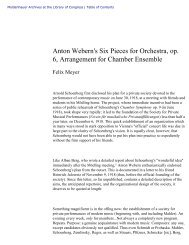Country Profile: Cuba - American Memory - Library of Congress
Country Profile: Cuba - American Memory - Library of Congress
Country Profile: Cuba - American Memory - Library of Congress
You also want an ePaper? Increase the reach of your titles
YUMPU automatically turns print PDFs into web optimized ePapers that Google loves.
<strong>Library</strong> <strong>of</strong> <strong>Congress</strong> – Federal Research Division <strong>Country</strong> <strong>Pr<strong>of</strong>ile</strong>: <strong>Cuba</strong>, September 2006<br />
Foreign Economic Relations: Prior to the <strong>Cuba</strong>n Revolution, <strong>Cuba</strong> traded mostly with the<br />
United States. Since the United States imposed an economic embargo against the Castro regime<br />
in October 1960, U.S. trade sanctions against <strong>Cuba</strong> have remained in effect. From the early<br />
1970s until the collapse <strong>of</strong> trade with the former Soviet bloc in 1990–91, more than 80 percent <strong>of</strong><br />
<strong>Cuba</strong>n trade was with Eastern Europe, mostly in nonconvertible-currency accounts (in effect, a<br />
barter arrangement). As <strong>Cuba</strong> sought to develop trade relations with the rest <strong>of</strong> the world after<br />
1991, it began to conduct bilateral trade with Eastern Europe, including Russia, at world market<br />
prices. Although <strong>Cuba</strong> has signed some trade agreements with Russia since 2001, <strong>Cuba</strong>n<br />
diplomatic efforts are more focused on deepening links with other potential trade partners such<br />
as China. The visit to <strong>Cuba</strong> <strong>of</strong> Chinese president Hu Jintao in November 2004 resulted in a set <strong>of</strong><br />
trade agreements, including one to export 4,400 tons <strong>of</strong> nickel per year to China. China has been<br />
particularly interested in investing in <strong>Cuba</strong>n infrastructure projects and in a major nickel mine in<br />
the east <strong>of</strong> the country. In 2005 China was <strong>Cuba</strong>’s second most important trading partner (10<br />
percent), mainly because <strong>of</strong> China’s sugar imports.<br />
The European Union (EU) accounts for about half <strong>of</strong> <strong>Cuba</strong>’s external trade, and tourism from<br />
Europe has become an important currency earner, especially since <strong>Cuba</strong> began to accept the euro<br />
as exchange currency in 1999. Formal <strong>Cuba</strong>n-EU relations remain cool, however, because by<br />
1996 EU states had adopted a “common position” that is staunchly critical <strong>of</strong> the lack <strong>of</strong> progress<br />
on human rights and democratization in <strong>Cuba</strong>. The EU has prevented <strong>Cuba</strong>’s accession to the<br />
Cotonou Accord, the mechanism through which it channels most developing country assistance<br />
and trade concessions. Nevertheless, the EU reopened diplomatic relations with <strong>Cuba</strong> in early<br />
2005, acknowledging the ineffectiveness <strong>of</strong> EU sanctions imposed on <strong>Cuba</strong> in June 2003.<br />
After <strong>Cuba</strong> lost support from the former Soviet bloc in 1990–91, the United States tightened<br />
economic sanctions against the island with the adoption in 1992 <strong>of</strong> the Torricelli Law. In 1996<br />
the U.S. <strong>Congress</strong> passed the Libertad (<strong>Cuba</strong>n Liberty and Democratic Solidarity) Act, also<br />
known as the Helms–Burton Law, which strengthened U.S. economic sanctions by threatening<br />
penalties for businesses known to have dealings with <strong>Cuba</strong>. After 1996 mounting pressure in the<br />
United States to relax sanctions led to some concessions, including permission for <strong>Cuba</strong>n-<br />
<strong>American</strong>s to send remittances <strong>of</strong> up to US$1,200 a year to relatives and, finally, in 2000 the<br />
legalization <strong>of</strong> food and medicine sales to <strong>Cuba</strong> beginning in January 2002. Under the George<br />
W. Bush administration, U.S. trade sanctions against <strong>Cuba</strong> intensified. On May 18, 2001,<br />
President Bush affirmed that his administration would “oppose any attempt to weaken sanctions<br />
against <strong>Cuba</strong>’s government…until this regime frees its political prisoners, holds democratic, free<br />
elections, and allows for free speech.”<br />
<strong>Cuba</strong>’s three most important regional trading partners are Canada, Mexico, and Venezuela—all<br />
three outspoken opponents <strong>of</strong> the U.S. economic embargo. In 2004 oil-rich Venezuela became<br />
<strong>Cuba</strong>’s main source <strong>of</strong> imports (21.3 percent) but only its third most important export destination<br />
(10.2 percent). The bilateral trade is based on the oil-for-doctors program, which reportedly<br />
provides health coverage for 17 million Venezuelans in return for oil. Venezuela began paying<br />
<strong>Cuba</strong> in 2005 for the approximately 20,000 doctors and other health-care pr<strong>of</strong>essionals working<br />
in Venezuela, as well as for the tens <strong>of</strong> thousands <strong>of</strong> eye surgeries and other medical operations<br />
that <strong>Cuba</strong>n hospitals provide Venezuelans. As a result <strong>of</strong> the People’s Trade Agreement signed<br />
16



![Albert Einstein Papers [finding aid]. Library of Congress. [PDF ...](https://img.yumpu.com/21604228/1/190x245/albert-einstein-papers-finding-aid-library-of-congress-pdf-.jpg?quality=85)





![American Colony in Jerusalem Collection [finding aid]. Library of ...](https://img.yumpu.com/17941275/1/190x245/american-colony-in-jerusalem-collection-finding-aid-library-of-.jpg?quality=85)



![Piccard Family Papers [finding aid]. - American Memory - Library of ...](https://img.yumpu.com/17941234/1/190x245/piccard-family-papers-finding-aid-american-memory-library-of-.jpg?quality=85)


